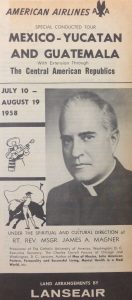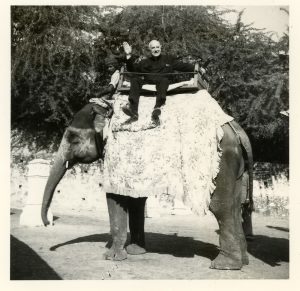
Author Katherine Santa Ana served as Graduate Library Pre-Professional (GLP), 2015-2017.
One particular character looms large at the American Catholic History Research Center and University Archives: the Rev. Msgr. James Magner (1901-1995). Born in Illinois, he attended Saint Mary of the Lake Seminary, was ordained in 1926 and completed his higher education in Rome at the Urban College of the Propaganda Fidei and the Academy of Saint Thomas Aquinas. Magner joined The Catholic University of America community in 1940, where he held many roles over the years including Assistant Secretary Treasurer, Director of the University Press, and Vice Rector for Business and Finance, as well as occasionally lectured. Retiring in 1968, he gave 28 years of service to the University.
That short biography fails to encompass the wide-ranging interests and hobbies of this unique – dare I say quirky – priest. An avid traveler and collector, the Archives received his estate in 1995, including many museum objects brought back from abroad. As Magner explained in his memoirs, “Travel has been among the most rewarding experiences of my life. I have regarded it, not merely as a holiday or change from my regular occupations, but really an opportunity to broaden and deepen my knowledge of the world and its people.” His lifelong love of travel began in the 1930s, as he explored Mexico. In the 1940s, Magner began organizing and leading seminar group tours of Mexico for Catholic University students. Today, the Archive’s Magner Museum Collection includes over one hundred Pre-Columbian objects brought back from Mexico and several other Central and South American countries, a selection of which are currently on display in the Archive’s reading room.

In the 1950s, Magner expanded his travels and tours to all over the world. In July of 1951, he conducted a world tour utilizing the latest exciting development in commercial travel: the airplane. As he explains in his memoir My Faces & Places Volume II, 1929-1953:
“I undertook this tour around the world by air, as something of a stunt, but it turned out to be one of the most exciting and educational experiences in my life. It was like a review of the history of the great cultures of the world compressed into a page. I truly felt that I have gone Jules Verne one better.”
Upon his return, Magner gave a lecture, “Around the World in Forty Days”, on his experience. This lecture gives a tantalizing glimpse into the politics and headlines of the time, including the rising tensions in Palestine and between Pakistan and India.

By the 1960s, Magner had added quite the roster of countries to his summer tours, including many under the sway of the Soviet Union. Magner had personally been traveling within the Soviet Union and the Eastern Bloc since 1956. When asked why he made these daring trips, he explained he wanted to see for himself what was going on behind the Iron Curtain. These excursions occurred largely without incident, with one exception. Prior to his 1965 tour of Czechoslovakia, Poland, Russia, Ukraine, Romania, Bulgaria and Yugoslavia, the Polish consular office initially declined to give Magner a visa. According to Magner, “apparently they feared that I might be on a secret mission or wondered why a Catholic priest had to go with the group.”
James Magner, priest, scholar, collector, traveler, and university administrator, retired to West Palm Beach, Florida in 1968. Not one to sit ideally by even if retired, he served two parishes in the area as a visiting priest, wrote his memoirs, and continued to amass a collection of books, art and artifacts. December 30, 1994, Rev. Msgr Magner passed away at the ripe old age of 93. He shared his experiences abroad not only with those he brought on his tours, but also the many attendees of his lectures where he often shared films of his travels. His legacy lives on at the Archives through his personal papers and museum objects as well as his donation of the historically significant Iturbide-Kearney Family Collection. On The Catholic University of America campus, a building bears his name in the Centennial Village residential community.
